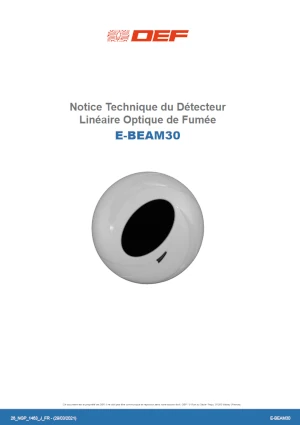When the DEF network wants to rationalise its technical documentation

The DEF network, a unique group of more than 50 companies
Created in 1958, the DEF network is an independent company network of fire safety experts with around forty companies in France and 10 or so outside France. Design, installation, maintenance, distribution, each one of the member companies contributes its expertise in fire protection. In 2020, the network generated sales of €236 million and boasted more than 2,400 employees throughout the world. This unique network is built around for divisions: the France division, the international division, the distribution division and the industrial division, the latter being in charge of technical writing.
Strong growth in the number of network companies and acceleration of international growth
Development of the DEF network is carried out via external growth and acquisition of competencies. Rapid change which has led to an increase in the number of technical documents to be produced and which, given the diverse nature of the different DEF member companies, also involved new constraints for the writer teams. These teams, who work using Word, had to manage a significant increase in their workload: ever-more documents in several different languages. Management began to search for a structured writing software package.
How can technical document creation be optimised at the network level?
The challenge was clearly defined: combine all content using one software package to prevent each company for using their own solution. It is against this backdrop that management defined the specifications, including setting four targets: producing documents more rapidly, standardising them at the network level, by reducing their number and steering translation.
After a traditional prospection phase, the DEF network turned to the Calenco solution, a SaaS platform for document production developed by the French software publisher NeoDoc.
Validation of the Calenco solution required several demonstrations, to gain a perfect understanding of the approach and how it works, and this also included the implementation of new work processes. It is in this connection that Brice Caron joined us three years ago at the DEF network’s industrial division as head of technical writing. He said: “My goal was clear: to implement a more efficient solution for writing and editing certain types of documentation.” Among the initial content considered, there were technical manuals, technical information sheets, and simplified technical notices. Documents which are often complex, and some form part of the certified product documentation in line with the Production and Construction Regulation.
Another point, each commercial entity within the DEF network had to be able to benefit from its own personalised documentation (logo, name and colour codes), as well as the same document content depending on the product type in question.
And the third consideration is translation. The international development of the DEF network has led to an increase in the number of translations to be managed. We could no longer limit ourselves to just French and English. It was essential to have the means to steer translations more efficiently to monitor the status of ongoing document projects.
The solution: a single platform for content creation, for all of our partners
The Calenco teams devised a fully customised solution to meet the needs of the industrial division of the DEF network. A project rolled out over more than three years, the document component involving the implementation of the Calenco solution was significant: involving more than 100 documents in several languages.
At the heart of the methodology, the Content fragmentation, a feature that facilitates the reuse from texts and Illustrations within the various documents. In this way, many text items shared with several manuals or information notices can be reused from a single source, without the need for copy/paste functions, which can often be time consuming and the source of many errors.
The Calenco teams developed a style sheet design function, enabling each document to be adjusted to the needs of each network company (name, logo, colour codes) while also complying with the overall graphics charter: guaranteed standardisation, and simplified personalisation. All using one software package.
Lastly, even though the DEF network does not yet use the Calenco platform to manage its translations, the possibility of extracting files, using XML format, to then send them to the translation agency, nevertheless, makes managing workflow easier.
A radical change to the technical writing approach
The implementation of the Calenco solution required a change in the technical writing approach. Standardised construction, precise and guided creation, uniformity. At present, the result is clear: everything is more structured: writing standards, the writing process, proofreading, translation phases and approval systems.
Another key factor underlined by the DEF network teams: the shift in working methods. Switching to the Calenco solution has prompted various player to accept giving up full control of the document creation process (style and content). At present, many new users want to use the software, proof that the teams have become proficient in its use. The greater ease of use offered by the Calenco solution enables optimum and autonomous management of subscriptions and users. Similarly, it offers the option, via the style sheet design function, of creating personalised style sheets directly without requiring the intervention of developer teams. Design which offers a great deal of freedom to customers.
And, tomorrow?
For the DEF network, the challenge now resides in managing the translation component. Switching to Calenco to integrate this component would the DEF network to maintain full control of content, notably that published by distributors, to ensure full compliance with the graphics charter and to optimise costs, as translation is a significant budget component for the DEF network. New projects could also be rolled out: environmental fact sheets, lifecycle analysis reports could also be drawn up using the Calenco solution, with a clear target: continuously striving for greater efficiency.
“The objectives initially set, namely to produce precise, homogeneous, faithful documents the constraints of the graphic charter and much more effectively, have been fully fulfilled”. concludes Brice Caron. “It is quite simply a joy to use this solution on a daily basis and there is no going back now.”
“Supporting our customers in the structural changes of its methodology approach for technical writing is a great source of satisfaction for our team” notes Camille Begnis, founder of NeoDoc. “Calenco is a great source of time savings and efficiency gains for our customers but also involves the pleasure of working together differently.”




